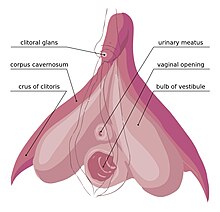Clitoral erection


Clitoral erection (also known as clitoral tumescence or female erection)[1][2] is a physiological phenomenon where the clitoris becomes enlarged and firm.
Clitoral erection is the result of a complex interaction of psychological, neural, vascular, and endocrine factors, and is usually, though not exclusively, associated with sexual arousal. Erections should eventually subside, and the prolonged state of clitoral erection even while not aroused is a condition that could become painful.[3] This swelling and shrinking to a relaxed state seems linked to nitric oxide's effects on tissues in the clitoris, similar to its role in penile erection.[4]
Physiology

The clitoris is the homolog to the penis in the male. Similarly, the clitoris and its erection of it can subtly differ in size.[5]
The visible part of the clitoris, the glans clitoridis, varies in size from a few millimeters to one centimeter and is located at the front junction of the labia minora (inner lips), above the opening of the urethra. It is covered by the clitoral hood.
Any type of motion can increase
Clitoral erection occurs when the
During sexual arousal, arterial blood flow to the clitoris is increased, and within the clitoris, the arteries further branch to supply the erectile tissues. The trabecular smooth muscles of the erectile tissue relax increasing blood flow to fill the vascular spaces, and expanding the erectile tissues until they are fully engorged with blood.
Medical conditions
Clitoral priapism
Priapism, while more common in males, is a condition that can also affect the clitoris.[3] Symptoms include painful engorgement of the clitoris, swelling of the clitoris, and pain in the area around the clitoris.[11]
Other animals
Among capuchin monkeys, clitoral erection is possible and makes the clitoris more visible than in its relaxed state where it is hidden by a preputial fold.[12]
See also
Notes
- ISBN 978-0-8261-3775-3. Retrieved 3 October 2023.
- ISBN 978-1-4557-7005-2. Retrieved 3 October 2023.
- ^ S2CID 20764733.
- ^ Gragasin, F. S., Michelakis, E. D., Hogan, A., Moudgil, R., Hashimoto, K., Wu, X., ... & Archer, S. L. (2004). The neurovascular mechanism of clitoral erection: Nitric oxide and cGMP‐stimulated activation of BKCa channels. The FASEB journal, 18(12), 1382-1391.
- S2CID 195758555.
- ISBN 978-1-264-26541-1.
- ISBN 978-1-935281-77-1. Archivedfrom the original on 28 February 2023. Retrieved 17 March 2015.
- ISBN 978-1-285-40102-7. Archivedfrom the original on 28 February 2023. Retrieved 17 March 2015.
- ISBN 978-1-84214-263-9. Archivedfrom the original on 28 February 2023. Retrieved 5 November 2020.
- ^ ISBN 978-0-253-11704-5. Archivedfrom the original on 28 February 2023. Retrieved 29 March 2015.
- from the original on 15 November 2021. Retrieved 2 December 2021.
- ^ Carosi, M, Spani, F, Ulland, AE, Scalici, M, Suomi, SJ. Clitoral length in immature and mature captive tufted capuchin (Sapajus spp.) females: A cross-sectional study. Am J Primatol. 2020; 82:e23135. https://doi.org/10.1002/ajp.23135
References
- Akkus, E. C.; Carrier, S.; Turzan, C.; Wang, T. N.; Lue, F. (April 1995). "Duplex ultrasonography after prostaglandin E1 injection of the clitoris in a case of hyperreactio luteinalis". The Journal of Urology. 153 (4): 1237–1238. PMID 7869513.
- Gharahbaghian, L. (1 November 2008). "Clitoral priapism with no known risk factors". The Western Journal of Emergency Medicine. 9 (4): 235–237. PMID 19561754.
- Gragasin, S.; Michelakis, D.; Hogan, A.; Moudgil, R.; Hashimoto, K.; Wu, X.; Bonnet, S.; Haromy, A.; Archer, L. (September 2004). "The neurovascular mechanism of clitoral erection: nitric oxide and cGMP-stimulated activation of BKCa channels" (Free full text). The FASEB Journal. 18 (12): 1382–1391. S2CID 45447939.
- Park, K. G.; Goldstein, I.; Andry, C.; Siroky, M. B.; Krane, R. J.; Azadzoi, K. M. (March 1997). "Vasculogenic female sexual dysfunction: the hemodynamic basis for vaginal engorgement insufficiency and clitoral erectile insufficiency". International Journal of Impotence Research. 9 (1): 27–37. PMID 9138056.
- Shen, W. U.; Urosevich, Z.; Clayton, D. O. (June 1999). "Sildenafil in the treatment of female sexual dysfunction induced by selective serotonin reuptake inhibitors". The Journal of Reproductive Medicine. 44 (6): 535–542. PMID 10394548.
- Toesca, A. S.; Stolfi, V. M.; Cocchia, D. (1 June 1996). "Immunohistochemical study of the corpora cavernosa of the human clitoris". Journal of Anatomy. 188 (Pt 3): 513–520. PMID 8763468.
